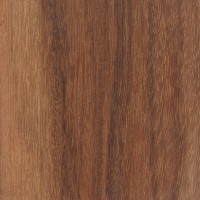 |
Common Name(s): Macacauba, Macawood, Hormigo, Orange Agate Scientific Name: Platymiscium spp. Distribution: Central and South America Tree Size: 65-80 ft (20-25 m) tall, 2-3 ft (.6-1.0 m) trunk diameter Average Dried Weight: 59 lbs/ft3 (950 kg/m3) Specific Gravity (Basic, 12% MC): .81, .95 Janka Hardness: 2,700 lbf (12,030 N) Modulus of Rupture: 21,540 lbf/in2 (148.6 MPa) Elastic Modulus: 2,837,000 lbf/in2 (19.56 GPa) Crushing Strength: 11,700 lbf/in2 (80.7 MPa) Shrinkage: Radial: 2.8%, Tangential: 4.2%, Volumetric: 7.2%, T/R Ratio: 1.5 |
Color/Appearance: Heartwood color can be highly variable, ranging from a bright red to a darker reddish or purplish brown, frequently with darker stripes. When the wood is referred to as “Hormigo,” various suffixes are used to describe the heartwood color: “Hormigo Negro” for darker pieces or “Hormigo Rojo” for orangish red pieces. Clearly demarcated sapwood is yellow to white.
Grain/Texture: Grain is straight to interlocked, with a medium to fine texture. High natural luster.
Endgrain: Diffuse-porous; large pores in no specific arrangement; solitary and radial multiples of 2-3; heartwood mineral/gum deposits (yellow) occasionally present; growth rings indistinct; narrow rays not visible without lens, normal to close spacing; parenchyma lozenge, confluent, and banded (not marginal).
Rot Resistance: Heartwood is rated as durable to very durable regarding decay resistance, with good resistance to insect attacks as well.
Workability: Overall, good working characteristics for both hand and machine tools, though areas of interlocked grain should be approached with care to avoid tearout. Able to take a very high natural polish. Turns and glues well.
Odor: No characteristic odor.
Allergies/Toxicity: Besides the standard health risks associated with any type of wood dust, no further health reactions have been associated with Macacauba. See the articles Wood Allergies and Toxicity and Wood Dust Safety for more information.
Pricing/Availability: Commonly imported under a variety of common names, and in a number of forms (lumber, turning blanks, flooring, etc.). Expect prices to be moderate for an imported exotic hardwood.
Sustainability: Macacauba is not listed in the CITES Appendices or on the IUCN Red List of Threatened Species, although a single Costa Rican species, Platymiscium pleiostachyum, is listed as endangered. The species is estimated to have less than 2,500 mature individuals still living, and the population is estimated to continue to decline at least 20% over the next two generations. This species has been exploited for lumber in the past, but there’s no indication that it’s been exported internationally.
Common Uses: Furniture, cabinetry, veneer, musical instruments, turned objects, and small specialty wood items.
Comments: This wood goes by a number of common names, with none of them having a clear predominance. Macacauba or Macawood is usually used when referring to the lumber, while Hormigo is more commonly used for specialty applications such as turning or musical instruments. Orange Agate has also been used as a trade name to help sell the wood. The ambiguous name Granadillo is also sometimes applied to this wood (along with dozens of other species).
None available.


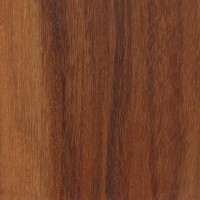
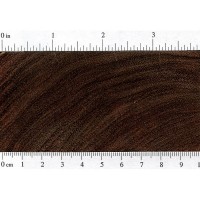
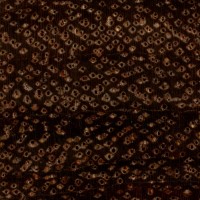
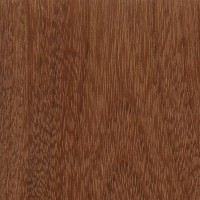
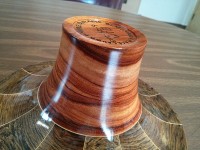
I have a piece of Macacauba that I got from Cooks, and it doesn’t seem to fit the description here. It feels relatively hard, but it’s not at all oily even after cutting. It feels very dry and splintery. That said, it is dense and has a bit of weight to it. It’s a light brown but isn’t particularly attractive looking at all. The grain is straight and very consistent… not a lot of variation or detail. Doesn’t seem like it would take a natural polish at all (too dry). It’s the blank on the bottom of the photo.
Wonderful for use in acoustic instruments.
Macacauba has quite strong ,very pleasant odour. This odor is persistent, i.e. distinct even long after processing.
Macacauba (Platymiscium spp.) has a mild vanilla odor, sweet.
Hello ! I work with wood for 40 years and spent 20 in the Amazon… Specially picking rare and precious woods for the american market…. MACACAUBA has a specific odor, as others on this site classified as “no specific odor”… Macacauba odor is very sweet whatever its type (dark, middle and light orange colored, figured…). I always love to have a piece on the lathe!! Sometime in the Amazon you need to smell the wood to identify a specie. There is so many different wood that look and weight the same but not one has the same smell, look and… Read more »
Dear Eric & Eric I get my wood from a very experienced supplier here in Italy, a guy who spent 40 years travelling the world to buy logs both for boards and to make veneer. He sold me two boards of mexican “granadillo”, which they sell as Platymiscium Yucatanum, but these have a very different appearance: darker and denser on the left, striped and more reddish on the right. I asked him about this, but he said that the trees look absolutely the same, and he has absolutely no way to distinguish them from the the tree or from the… Read more »
Is it possible that it is dalbergia granadillo, which is also sometimes sold as granadillo. I doubt it would be noticeably more dense than macacauba, however, it would likely be more reddish with more pronounced stripes. Another tell-tale difference between these two species would be pore density and smell, with dalbergia granadillo having a rose-like scent. Hope this may help!
I purchased a lathe from a person who is now deceased he worked for hardware lumber company, and I now have a lot of different hardwoods. I have some Macacauba.that I wanted to use in cutting boards but i don’t know if this wood should be used for that purpose. Any information you can provide would be appreciated.
I have a good number of salvaged boards and beams that were used to crate granite slabs shipped from Brazil. They are exceptionally dense and heavy, dark reddish brown in color. A Brazilian co-worker of mine took one look at this wood and said “That’s Angico Rojo”. Don’t see this name in your database. Any thoughts?
Actually the “folk” name for the wood is “hormingo rojo” or “red concrete.” Naturally it got it’s name from its hardness (2,720) and the redish color when it is first harvested. I have some of this wood. The outside is very brown, but when I cut it, the red is quite obvious.
I’ve built & finished a coffee table using Macacauba, and I’m experiencing an issue with a white powdery substance forming on the surface of the wood. It seems to happen most noticeably after fluctuations in humidity. The finish consists of three coats of 1# shellac and seven coats of Tried and True varnish oil. The shellac was applied over the course of three days, and the oil varnish over two weeks. I then buffed the table a couple times a day for a week, and finally applied two coats of Renaissance wax. The finish took just fine (that is to… Read more »
I have the same problem with Granadillo, especially the redder specie. I use…get this…Renaissance Wax, and on my cutting boards…Tried and True. Could it be the extractives in the wood working on the wax? Anyone else?
Quick update. That white powdery/waxy substance only seems to form on the wood after some sort of finish has been put on/ It rarely forms while the wood is in storage.
Finishing oily exotic woods has a steep and frustrating curve of learning. My suggestion is read the luthiers approach. My method is to first fill the Poor’s/grain because this is where the oils live, then seal the wood with either shellac or vinyl sealer, then I find the best finish is several high gloss coats of laquer or high quality polyurethane, with French polish using several polish compounds until desired look is aquired. Oil finishes look great but will likely never dry. Remember one part of the tree or log may be oil free while another section may have lots,… Read more »
Marimba keys are made of Platymiscium dimorphandrum, But i didn’t know what to call it. should make a great tone wood for guitars.
What is the tone like on guitars…is it Rosewood…is it close to Brazilian Rosewood….?
Gibson is using it for fret boards on the 2018 explorer
Piatti in macacauba fatti a Torino Italy
NICE! AUGURI!
Smells like gardenia flowers when turning to me…
I made two canes out of Granadillo. Polyurethane sprayed, or brushed, will not dry.
Check out the article on finishing exotic woods for more information: https://www.wood-database.com/wood-articles/finishing-exotic-tropical-hardwoods/
Michael,
I updated the primary pictures with scans from a lighter, more reddish orange sample to better approximate the color of the wood.
Most of the Macacauba I have seen has a more redish to orange coloring, the sapwood can be almost white. The grain patterns at time can be a very dark almost black at times, the photos displayed look more like Ipe than Macacauba which is also referred to as Monkey Wood in the Amazon Basin.